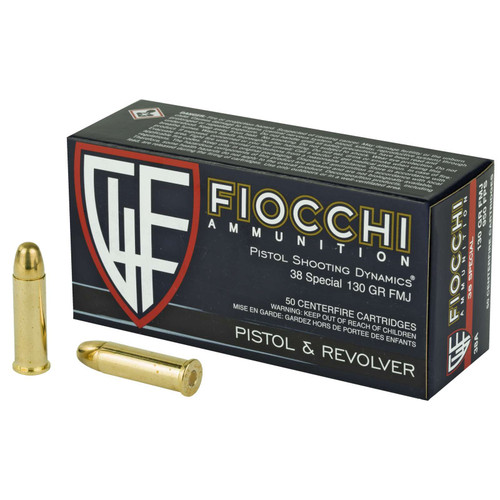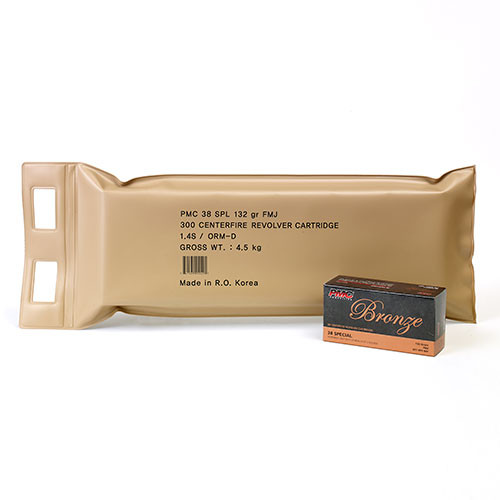.38 Special Ammo

.38 Special: In Depth
By 1900, black powder revolvers were technically obsolete, yet still in common use by American military and police forces. Despite the fact that these guns chambered brass-cased ammo, most of the cartridges they fired barely broke the 700/fps mark, and with fairly lightweight bullets to boot. Purpose-built smokeless powder shooters were around, but not in great numbers, and running the newer powder technology in older, weaker-framed guns could instantly spell their ruin (they’d blow up). Also acutely adding to the bad rap for black powder blasters were reports from overseas that the Army’s .38 Long Colt cartridge failed to drop charging attackers, even with well-placed shots. So, there was hunger for a performance upgrade, but at this point, it wasn’t necessarily time to abandon the revolver altogether. In fact, the US Army’s .38 Long Colt revolver cartridge would hang on to its place as primary sidearm ammunition until 1911 – a year that many firearms enthusiasts know well for the introduction of a certain rimless cartridge automatic pistol.
Right in the middle of the old .38 Long Colt’s service life, Smith and Wesson lengthened its brass case and upped the powder charge, calling the result .38 Smith and Wesson Special. Shortly thereafter, smokeless powder would be substituted for the black powder, further increasing the cartridge’s velocity. By that time, .38 Special featured a 158-gr. LRN (lead round-nose) bullet traveling at roughly 800/fps, and S&W saw fit to update one of their most popular revolvers in order to highlight the round. Chambered especially for the .38 Special cartridge, and fittingly named for its intended target markets, the 1902 version of the S&W Military and Police revolver gathered momentum quickly in both of its namesake arenas – particularly in American law enforcement service.
During WWI, M1911 production was insufficient for supplying the large number of troops deployed overseas, so a 1905 version of the S&W M&P would bolster sidearm inventories at the time. This became a pattern, as WWII saw the Navy and Marine Corps use another M&P variant, the S&W Victory, heavily some twenty-five years later.
Even though the heavier hitting .357 Magnum and even more-powerful revolver cartridges made their marks as early as the 1930s, .38 Special remained the cartridge of choice for US law enforcement for the majority of the 20th century. Shooters appreciated the manageable recoil of the cartridge, even when +P loads were used. The all-steel frames of the contemporary LE revolvers such as the aforementioned M&P or Colt’s Official Police also tamed whatever snappiness might have been there in the first place. Smaller-framed .38 Special snub noses pulled backup duty, often in ankle holsters, as they were easier to conceal.
The desire for better ballistics and more capacity eventually sent .38 Special on its way in favor of .40 S&W and 9mm Luger in the law enforcement sphere. However, newer lightweight metal revolvers chambered in .38 Special continued to be used as backups, during off-duty carry, and for concealed carry by the wider public. In fact, much of the current market activity for this cartridge is concealed carry related. Many folks point to the reliability of revolvers in close-quarters encounters – even that they can be fired multiple times from underneath clothing or within a fanny pack or purse – as semi-autos might struggle here. Others highlight the simplicity of the revolver in terms of overall handling and ease of maintenance. Regardless of one’s philosophy concerning carry, however, the .38 Special cartridge is certainly capable of stopping threats, even if capacity is somewhat limited compared to a modern semi-auto.
.38 Special: Guns
Smith and Wesson’s 1902 M&P (Military and Police) Model revolver was the first firearm made specifically for the .38 Special, entering the scene right as smokeless powder was really taking off. Early guns fired a load roughly equivalent to the .38 Long Colt, but it wouldn’t be long before revolver frames and the new load itself were beefed up to handle extra pressure. As a result, there are a few different stampings you may encounter on your barrel: .38 Special, .38 Special +P, and .357 Magnum. As always, make sure the stamp on your barrel and the writing on your box of ammo agree with each other!
.38 Special Revolvers
- Smith and Wesson Military and Police / Victory
- Colt Original Police / Commando
- Colt Detective Special
.38 Special +P Revolvers
- Ruger SP101
- Smith and Wesson Model 36 Classic
- Ruger LCR
- Smith and Wesson Model 642
- Taurus 856
- Smith and Wesson M&P Bodyguard
.357 Magnum Revolvers
- Ruger GP100
- Smith and Wesson Model 27 Classic
- Colt Python
- Smith and Wesson Model 686
- Taurus 65
Carbines / Rifles (.357 Magnum Chambers)
- Henry Big Boy Steel Side Gate Carbine
- Winchester Model 1892
- Marlin Classic Series Model 1894
- Winchester Model 1873
Why Choose .38 Special?
This cartridge is among the most popular and well-known of all revolver rounds. In particular, the .38 Special’s close association with law-enforcement is responsible for much of the enduring respect and tradition surrounding it. The fact that you can shoot it through a firearm chambered in .357 Magnum is a huge plus as well.
Plinking / Target / Competition
- Great beginner cartridge for revolver shooting; can be fired safely through a gun chambered in .357 Magnum.
- Competition use goes back to the beginning of the 20th century.
- Tube-fed carbines chambered in .38 Special increase muzzle velocity for flatter shooting at longer distances.
Concealed Carry / Defensive Carry
- Small, lightweight revolvers chambered in .38 Special are a popular choice for concealed carry. People have been concealing guns like these forever – some of the first snub nose revolvers were chambered in .38 Special.
- Small revolvers, especially hammerless models, are capable of firing through a whole cylinder from within a cover garment or bag / purse, etc., making these guns popular for that style of carry.
- .38 Special +P defensive loads are a good alternative to 9mm Luger when a revolver is preferred.
Home Defense
- For home defense use, full-sized steel revolvers have largely taken a back seat compared with semi-autos mainly for capacity’s sake, though they are often still recommended for those not familiar with gun handling.
- For people that find it difficult to rack the slide on a semi-auto, a revolver is a superior option for home defense.
- Even though it’s long been a movie cliche to dramatically reveal a small snub nose within a desk drawer or nightstand, there is still an undeniable benefit to storing a compact little gun complete with ammo vs. a semi-auto with its mag that might get lost (and just as bad, potentially render the gun useless due to a magazine disconnect). Note: please store your firearms safely and securely!
Hunting
- While you can kill animals with this cartridge, most loads are subsonic and only start with 200-250 ft/lbs at the muzzle, with a few exceptions.
- Ballistics are improved when fired through a carbine, but .357 Magnum is still a better choice.
- Small shot loads are available for snake defense and small varmint control.
.38 Special: Ammo Brands and Loadings
.38 S&W Special is a rimmed cartridge, originally derived from the black powder .38 Long Colt, and is not considered a particularly powerful round (especially in its standard loading). However, higher-pressure +P variants have been around since the 1930s, and most quality revolvers will handle this ammo (check the manual for your firearm), including anything chambered in .357 Magnum. Even though .38 Special revolvers were used at various times by every branch of the US military, surplus ammo is not common for this cartridge. However, its seventy-five-odd years of law-enforcement dominance, ease-of-use for target shooting, and ongoing popularity for deeply-concealed carry all guarantee that plenty of different load choices are available.
Brands
- Federal, Winchester, Hornady, Remington, PMC, Magtech, Sellier and Bellot, Fiocchi, Armscor, Norma, Ammo Inc.
Standard Loadings
- 130-gr. FMJ @ 925/fps
- 158-gr. FMJ @ 770/fps
Bullet Types
- FMJ (Full Metal Jacket) - Target, plinking
- JHP (Jacketed Hollow Point) - Self defense
- LRN (Lead Round Nose) - Self defense, target
- Wadcutter - Target, self defense
- Monolithic / Penetrator - Self defense w/ barrier penetration
- Shot Capsule - Snake, rat and other small critter control
Bullet Weights
- 110-gr. - JHP, high velocity rounds
- 125-gr. to 130-gr. - Standard weights
- 158-gr. - Original weight, also very common
Velocities (Including +P Ammo)
- 110-gr. - 900/fps to 1000/fps
- 125-gr. to 130-gr. - 800/fps to 900/fps
- 158-gr. - 750/fps to 900/fps
+P Ammunition
- .38 Special +P ammunition, which indicates higher chamber pressure, is quite common for this cartridge.
- Any revolver chambered in .357 Magnum is capable of handling the increased pressure of these loads, as is any barrel stamped “.38 Special +P”.
.38 Special: Frequently Asked Questions
They both use .357 caliber projectiles (.358 with unjacketed, bare-lead projectiles). The .357 Magnum has a longer case than .38 Special – 0.135” longer, to be exact.
.38 Special ammunition will chamber in and is safe to fire from a .357 Magnum firearm, but not the other way around.
One way is to look at what’s stamped on the barrel. A barrel stamped “.38 Special” is not designed for .38 Special +P ammo, whereas a barrel stamped “.38 Special +P” will safely shoot both .38 Special and .38 Special +P. If you have one, refer to your firearm’s instruction manual to see if the gun is capable of shooting +P ammo. Contact the manufacturer and ask this question directly, if necessary.
Vintage .38 Special revolvers should not be fed +P ammo. Most full-size revolvers are now chambered in .357 Magnum. This chamber can safely shoot .357 Magnum, .38 Special +P, and .38 Special loads. You cannot fire a .357 Magnum round from a .38 Special firearm, as the .357’s case is longer and it likely will not even chamber in the cylinder.
People have been carrying small purpose-built concealable revolvers chambered in .38 Special since the days of the Colt Detective Special (introduced 1927). Really, up until the micro 9s debuted, these guns were the best options for deeply-concealed carry. Also, manufacturers have been replacing the steel in these guns with other metals in order to shed weight since the 1950s. In short, there is a long tradition of .38 Special carry and it remains a good cartridge for that application.
A .38 Special +P loading with a highly-expanding bullet such as Federal’s Hydra-Shok Deep Jacketed Hollow Point is recommended for defensive carry. However, it’s worth pointing out that similar loadings in 9mm Luger +P are much more powerful.
Revolver hunting is best left to cartridges with considerably more beef than .38 Special. The energy delivered is just not enough to hunt most game ethically. Specialty shot rounds are available with a small pellet load suitable for snakes and rats.









